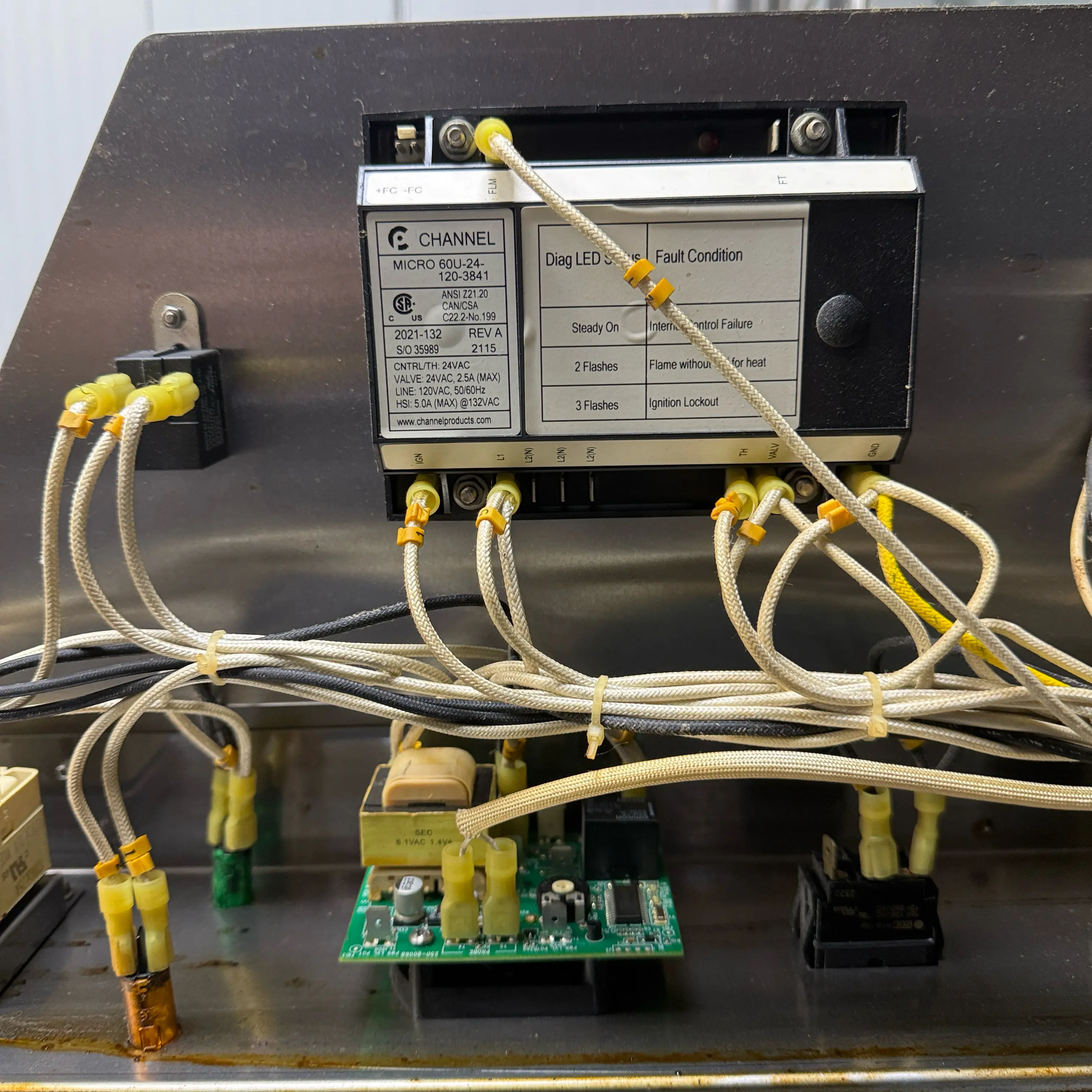Viking Appliance Repair Services
We repair Viking ovens, dishwashers, cooktops & more — factory-trained, local techs.
Volt & Vector Appliance Repair
Our licensed technicians specialize in repairing Viking’s most popular home appliances. Whether it’s a minor issue or a complex malfunction, we deliver fast, effective service for:
Viking appliances, known for their high-performance engineering and commercial-grade design, are prone to specific mechanical and electronic failures despite their robust build. Wall ovens frequently display F1 (keypad input failure) or F2 (oven temperature sensor fault) errors, often caused by stuck keypad buttons , open RTD sensors (typically 1,080Ω at 77°F), or failed control boards . Some models may show F001 (sensor short/open) or F002 (board communication loss), which can lead to uncontrolled heating or shutdowns. Ranges that fail to maintain consistent heat often trace to failed oven control relays (e.g., Omron-style units) or degraded bake elements with resistance values outside the 30–50Ω range.
Gas burners that click continuously or fail to ignite frequently log E001 (ignition failure) or E002 (spark circuit fault), pointing to cracked igniters , shorted spark electrodes , or failed spark modules . These issues are exacerbated by grease buildup or moisture intrusion around burner bases. Refrigerators running constantly but failing to cool often trigger E1 (temperature sensor fault), E2 (evaporator fan failure), or defrost system errors like F4 (defrost heater open) or F5 (adaptive defrost sensor fault). Ice makers may leak or jam due to frozen fill tubes (triggered by low water pressure or failed inlet valves) or faulty sensor arms that fail to detect full ice bins.
Electric cooktops with indicator lights stuck on typically suffer from stuck infinite switches (mechanical relays) or shorted element control loops , causing elements to remain partially energized even when turned off. Oven cooling fans that become noisy or stop running entirely often indicate worn fan motors or blocked airflow from grease accumulation in commercial-style units. Touch panels on high-end models may become unresponsive or flicker due to disconnected ribbon cables , failed capacitive UI boards , or low-voltage power supply instability , especially in older units with degraded capacitors.
Viking’s modular design simplifies repairs, as key components like relay boards , RTD sensors , and spark modules are swappable rather than integrated into mainboards. However, IGBT-based induction cooktops may require specialized diagnostics for F47 (pan detection failure) or F4 (inverter overtemperature) codes, often tied to overheating or component degradation. Many Viking parts (e.g., fan motors , relays , igniters ) are cross-compatible with Thermador and Bosch due to shared BSH Group engineering. Repairs are typically justified for units under 8–10 years old , while older models with systemic failures (e.g., inverter board replacements , compressor issues ) may warrant upgrading. Viking’s inclusion of detailed service manuals inside panels or via BSH support further aids technicians, though premium parts (e.g., UI boards , IGBT modules ) and labor costs can still influence the repair vs. replacement decision.
Viking appliances combine commercial-grade engineering with repair-friendly design, making them a favorable option for technicians and owners seeking long-term serviceability. Modular construction is a core strength, with key components like UI boards , relay boards , spark modules , and burner control assemblies built as isolated, swappable units. For instance, a failed oven control relay board (VRSC4300A, ~$250–$400) can be replaced independently of the main logic board, avoiding costly full-system overhauls. Similarly, gas ignition systems use standardized spark modules (e.g., VRSC4100B, ~$150–$200), compatible with Dacor and Wolf models, reducing part sourcing delays.
Accessible components further enhance repair efficiency. Most Viking units feature screwed panels and open chassis designs that simplify teardown, allowing technicians to replace parts like fan motors , RTD temperature sensors , or infinite switches without extensive disassembly. For example, wall oven relay boards (VRSC4300A) are mounted behind removable panels, enabling quick access compared to fully integrated systems. This design also lowers labor costs, as repairs often take 1–2 hours rather than requiring full appliance removal.
The use of standardized relays and triacs aligns Viking with industry norms, ensuring compatibility with off-the-shelf components. Omron-style relays (e.g., G2R-1-E for oven controls) and triac-based power modules (e.g., BTA41-600B for cooktops) are widely available, simplifying replacements for issues like stuck switches or overheated circuits. For example, a failed spark module relay in gas models (VRSC4100B) can be swapped without replacing the entire ignition system—a contrast to brands using proprietary relays that force full board replacements.
No firmware locks on most models mean replacement control boards or modules can be installed without proprietary reprogramming tools, a rarity in high-end appliances. Exceptions include Wi-Fi-enabled models requiring app pairing, but even these often allow resets via Whirlpool/Viking diagnostic software (Tech2). For example, a UI board (VRSC4200C, ~$300–$500) in a Viking wall oven can typically be replaced without code syncing, unlike Thermador units tied to BSH’s locked ecosystems.
While Viking repairs can be costly due to premium part pricing (~$200–$800 for control boards), their modular design , standardized components , and cross-brand compatibility justify repairs for units under 8–10 years old . Older models or systemic failures (e.g., IGBT module replacements in induction cooktops) may warrant upgrading, but Viking’s repair-friendly architecture ensures long-term serviceability for most issues.
Most units do not use deep digital diagnostics, so error codes are limited (e.g., F1–F5). Repairs are grounded in hardware testing — continuity checks, relay diagnostics, sensor resistance, and visual inspection. We handle all Viking product lines, performing component-level service including fan motor replacement, board repair (relays, caps, solder joints), sensor calibration, and sealed system work on refrigerators.
Repairs backed by guarantee.
No hidden fees. Ever.
Trusted service. Certified technicians. Local expertise.
Volt & Vector is a Brooklyn-based appliance repair company serving NYC. We fix washers, dryers, ovens, fridges & more — fast, certified, and local.
.png)

.png)
.png)







